ARTICLE AD
On December 5th, 2020, Japan's Hayabusa2 mission successfully returned samples it had collected from the Near-Earth Asteroid (NEA) 162173 Ryugu home.
Since asteroids are basically leftover material from the formation of the Solar System, analysis of these samples will provide insight into what conditions were like back then.
In particular, scientists are interested in determining how organic molecules were delivered throughout the Solar System shortly after its formation (ca. 4.6 billion years ago), possibly offering clues as to how (and where) life emerged.
The samples have already provided a wealth of information, including more than 20 amino acids, vitamin B3 (niacine), and interstellar dust.
According to a recent study by a team of Earth scientists from Tohoku University, the Ryugu samples also showed evidence of micrometeoroid impacts that left patches of melted glass and minerals.
 The carbonaceous material found in the melt splash shows a spongy texture and contains small iron sulfide inclusions. (© Megumi Matsumoto et al., Science Advances, 2024)
The carbonaceous material found in the melt splash shows a spongy texture and contains small iron sulfide inclusions. (© Megumi Matsumoto et al., Science Advances, 2024)According to their findings, these micrometeoroids likely came from other comets and contained carbonaceous materials similar to primitive organic matter typically found in ancient cometary dust.
The team was led by Megumi Matsumoto, an assistant professor from the Earth Science Department at Tohoku University's Graduate School of Science. He was joined by researchers from the Division of Earth and Planetary Sciences at Kyoto University, the CAS Center for Excellence in Deep Earth Science, the Institute of Space and Astronautical Science (ISAS), the Japan Synchrotron Radiation Research Institute (JASRI), the Japan Aerospace Exploration Agency (JAXA), and NASA's Johnson Space Center.
The details of their findings were presented in a paper that recently appeared in the journal Science Advances.
Like the Moon and other airless bodies, Ryugu has no protective atmosphere and does not experience weathering or erosion.
This ensures that craters caused by past impacts on its surface (which is directly exposed to space) are carefully preserved despite the passage of eons.
These impacts generate intense heat that leaves behind melted patches of glass (aka. "melt splashes"), which quickly solidify in the vacuum of space. These impacts cause changes to the composition of the asteroid's surface materials, revealing information about the history of impacts.
After analyzing the Ryugu samples, Matsumoto and her colleagues found melt splashes ranging in size from 5 to 20 micrometers.
Their composition suggests they came from cometary sources that impacted Ryugu while it was in a near-Earth orbit.
 Left: A melt splash discovered on a Ryugu sample surface. The melt splash shows a round shape. Right: CT slice image of the melt splash exhibiting abundant voids inside. (© Megumi Matsumoto et al., Science Advances, 2024)
Left: A melt splash discovered on a Ryugu sample surface. The melt splash shows a round shape. Right: CT slice image of the melt splash exhibiting abundant voids inside. (© Megumi Matsumoto et al., Science Advances, 2024)"Our 3D CT imaging and chemical analyses showed that the melt splashes consist mainly of silicate glasses with voids and small inclusions of spherical iron sulfides," said Matsumoto in a recent Tohoku University news release.
"The chemical compositions of the melt splashes suggest that Ryugu's hydrous silicates mixed with cometary dust."
Their analysis revealed small carbonaceous materials with a spongy texture indicative of nano-pores, small voids caused by the release of water vapor from hydrous silicates.
This vapor was subsequently captured in the melt splashes, which also contained silicate glasses rich in magnesium and iron (Mg-Fe) and iron-nickel sulfides.
The carbonaceous materials are similar in texture to primitive organic matter observed in cometary dust but differ in composition – lacking nitrogen and oxygen.
Said Matsumoto:
"We propose that the carbonaceous materials formed from cometary organic matter via the evaporation of volatiles, such as nitrogen and oxygen, during the impact-induced heating. This suggests that cometary matter was transported to the near-Earth region from the outer solar system. This organic matter might be the small seeds of life once delivered from space to Earth."
Looking ahead, the team hopes to examine more Ryugu samples that will provide further insights into how primitive organic materials were delivered to Earth billions of years ago.
Similarly, scientists at NASA's Johnson Space Center recently completed the careful process of removing the samples collected by the OSIRIS-REx mission from their sample container.
Analysis of these samples will reveal the composition and history of asteroid Bennu, another NEA that will provide vital information on how our Solar System evolved.
This article was originally published by Universe Today. Read the original article.

 1 year ago
84
1 year ago
84 

